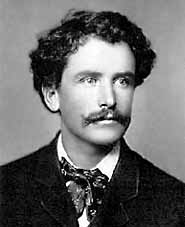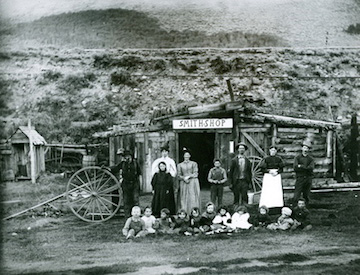Difference between revisions of "George Edward Anderson"
| Line 11: | Line 11: | ||
With a call to serve a mission in England in 1907, Anderson began photographing religious landmarks. He traveled throughout the eastern United States for about one year and then set sail for England in April 1908 where he took more photographs while he proselyted. After his release in March 1910, he stayed for over a year continuing his work as photographer and missionary. When he returned to the United States, he set up a studio near the birthplace of the Prophet [[Joseph Smith]] and photographed Church history sites and portraits of Church members and local residents. | With a call to serve a mission in England in 1907, Anderson began photographing religious landmarks. He traveled throughout the eastern United States for about one year and then set sail for England in April 1908 where he took more photographs while he proselyted. After his release in March 1910, he stayed for over a year continuing his work as photographer and missionary. When he returned to the United States, he set up a studio near the birthplace of the Prophet [[Joseph Smith]] and photographed Church history sites and portraits of Church members and local residents. | ||
| − | In November 1913, he returned to Springville, Utah, after an almost severn-year absence from his family. Consequently, his business and family life were strained. He was not able to revive his traveling tent studio, but profited from the sale of copies of ''The Birth of Mormonism'', a booklet The Deseret [[Sunday School]] Union of the Church published that featured some of his photographs. He devoted himself to documenting family life in Utah Valley and traveling to newly constructed temples. In 1923, he traveled with Church authorities to Cardston, Alberta, Canada, for the dedication of the [[Cardston Alberta | + | In November 1913, he returned to Springville, Utah, after an almost severn-year absence from his family. Consequently, his business and family life were strained. He was not able to revive his traveling tent studio, but profited from the sale of copies of ''The Birth of Mormonism'', a booklet The Deseret [[Sunday School]] Union of the Church published that featured some of his photographs. He devoted himself to documenting family life in Utah Valley and traveling to newly constructed temples. In 1923, he traveled with Church authorities to Cardston, Alberta, Canada, for the dedication of the [[Cardston Alberta Temple]] and spent two years there. In 1927, he again accompanied Church leaders to Mesa, Arizona, to document the dedication of the [[Mesa Arizona Temple]]. He had been ill prior to his departure and his wife had urged him to stay home. In May 1928, he had been brought home and died of heart failure on May 9, 1928. |
Anderson was somewhat obscure during his lifetime, but his work has been recognized and brought forward through the work of Rell G. Francis (a collector, historian, educator, and member of the board of trustees for the Springville Art Museum), Nelson B. Wadsworth (a professor, researcher, writer, and photographer), and [[Richard Holzapfel]] (a professor, historian, and author). | Anderson was somewhat obscure during his lifetime, but his work has been recognized and brought forward through the work of Rell G. Francis (a collector, historian, educator, and member of the board of trustees for the Springville Art Museum), Nelson B. Wadsworth (a professor, researcher, writer, and photographer), and [[Richard Holzapfel]] (a professor, historian, and author). | ||
Revision as of 18:30, 24 January 2019
George Edward “Ed” Anderson was an American photographer. Although known as a portrait photographer, he produced thousands of documentary portraits taken near homes, barns, and businesses. These photos document families, small town Utah history, railroad history, mining history, and the building of The Church of Jesus Christ of Latter-day Saints temples.
Anderson was born on October 28, 1860, in Salt Lake City, Utah. He apprenticed under renowned photographer Charles R. Savage and through work in Savage’s Art Bazaar Studio became friends with fellow apprentices John Hafen, who became an accomplished artist, and John F. Bennett, who was instrumental in preserving Anderson’s collection of glass plate negatives.
Anderson, at the age of seventeen, established his own photography studio in Salt Lake City with his brothers, Stanley and Adam. He opened traveling tent studios in Manti, Utah, Springville, Utah, and Nephi, Utah. He also established a stationary studio in Manti in 1886 where the Church was constructing a new temple. While in Manti, he met Olive Lowry and on May 30, 1888, they were the second couple to be married in the Manti Utah Temple. That year he sold his studio and established himself in Springville, Utah. His traveling tent studio, which he set up in small towns throughout Utah, documented the lives of residents from 1884 to 1907.
With a call to serve a mission in England in 1907, Anderson began photographing religious landmarks. He traveled throughout the eastern United States for about one year and then set sail for England in April 1908 where he took more photographs while he proselyted. After his release in March 1910, he stayed for over a year continuing his work as photographer and missionary. When he returned to the United States, he set up a studio near the birthplace of the Prophet Joseph Smith and photographed Church history sites and portraits of Church members and local residents.
In November 1913, he returned to Springville, Utah, after an almost severn-year absence from his family. Consequently, his business and family life were strained. He was not able to revive his traveling tent studio, but profited from the sale of copies of The Birth of Mormonism, a booklet The Deseret Sunday School Union of the Church published that featured some of his photographs. He devoted himself to documenting family life in Utah Valley and traveling to newly constructed temples. In 1923, he traveled with Church authorities to Cardston, Alberta, Canada, for the dedication of the Cardston Alberta Temple and spent two years there. In 1927, he again accompanied Church leaders to Mesa, Arizona, to document the dedication of the Mesa Arizona Temple. He had been ill prior to his departure and his wife had urged him to stay home. In May 1928, he had been brought home and died of heart failure on May 9, 1928.
Anderson was somewhat obscure during his lifetime, but his work has been recognized and brought forward through the work of Rell G. Francis (a collector, historian, educator, and member of the board of trustees for the Springville Art Museum), Nelson B. Wadsworth (a professor, researcher, writer, and photographer), and Richard Holzapfel (a professor, historian, and author).
Charles Reynolds, picture editor of the magazine Popular Photography, commented at a Brigham Young University photo seminar on December 11, 1973, about his introduction to Anderson’s photographs. After attending an exhibition at the Springville Museum of Art, arranged by Rell Francis, he said: “I go to shows several times a week in New York City . . . and I have rarely seen anything as impressive as those photographs. . . . It is awfully hard to astonish me. . . . The George Anderson pictures that I saw today weren’t sensationalized pictures in any way. They were very sweet, beautiful, lovely pictures.”<reference>Charles Reynolds, photo seminar, 11 December 1973, typescript from a recording made by the BYU Communications Department</reference>.
Reference

